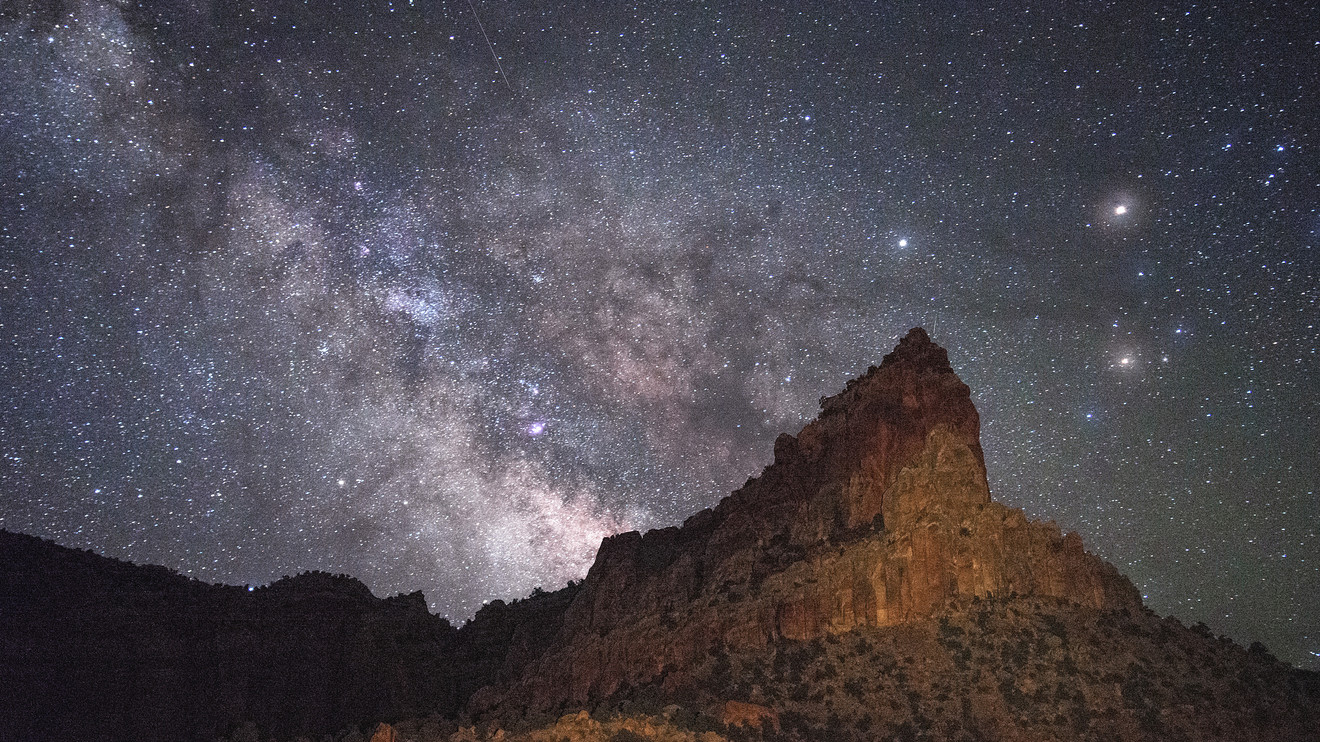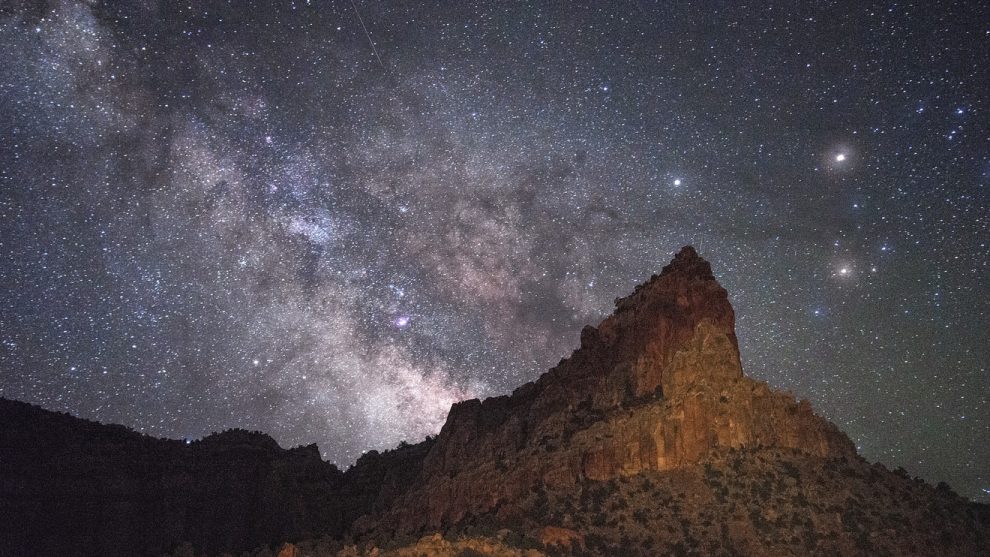
Look up at the sky in most big cities and you can spot 500 or so stars — and that’s on a good night. But what happens when you tilt your head back in a designated dark sky park? It’s twinkle, twinkle lots of stars. In fact, in a dark sky park, you can see as many as 15,000 stars, according to the National Park Service.
Why are dark skies important? Flashy billboards, streetlights and other forms of artificial light common in big cities not only obscures our views of starry skies, all that light can also disrupt ecosystems. That’s because wildlife depends on Earth’s light-dark cycle to cue everything from reproductive patterns to protecting themselves from predators.
Here’s some great news for your bucket list: you don’t need to travel all the way to Iceland to see the Northern Lights.
Some cities have chosen to limit excessive artificial lighting outdoors. Consider it conservation efforts for the night sky, with the International Dark-Sky Association and communities across the U.S. working together to prevent light pollution and earning an official Dark Sky Designation in the process.
Here are six star-studded communities across the U.S. that are going to infinity and beyond to protect their night skies, and, because of that, are truly remarkable places to stargaze.
1. Flagstaff, Ariz.
In all, there are 16 “dark sky communities” in the U.S., though several more parks and reserves qualify. Flagstaff, however, was the first city to ever receive the dark sky designation, doing so in 2001. The Arizona city, which is home to Lowell Observatory and the U.S. Naval Observatory Flagstaff Station, has a long history of defending its darkness. It enacted the world’s first outdoor lighting ordinance in 1958, according to the International Dark-Sky Association. Retired astronomer Christian Luginbuhl — a founding member of the Flagstaff Dark Skies Coalition, a chapter of the International Dark-Sky Association — says even in the city, Flagstaff residents can see the Milky Way overhead as long as they’re away from bright lights like streetlights. Luginbuhl says Flagstaff, as a community, has always valued its environment, including its surrounding forests, canyons, deserts and mountains. All of that contributes to the “Flagstaff quality of life,” he says, and it’s a natural addition to include the visibility of stars in such a concept. “The designation has helped open people’s eyes at night,” Luginbuhl says.
2. Borrego Springs, Calif.
California’s only International Dark-Sky Community is located in Borrego Springs, a desert oasis town in San Diego County. “Borrego Springs earned the Dark Sky distinction by restricting and modifying lights on public streets, outside of businesses and even on residents’ front porches,” says Robert Arends, public relations manager with San Diego Tourism Authority. Lending an assist is a high mountain range that shields the big, bright cities and towns of Southern California, as well as the 600,000-acre undeveloped wilderness of Anza-Borrego Desert State Park that surrounds the town on all sides, he explains.
Also see: 12 best American road trips
An unexpected spot to stargaze? The Springs at Borrego RV Resort, which features a small observatory that houses an 11-inch diameter telescope and holds public viewings and lectures several times a year. Visitors can also take a personalized tour of the cosmos with a telescope and renowned celestial tour guide Dennis Mammana, an astronomer.
3. Torrey, Utah
Honestly, you could go on an extremely impressive celestial circuit in Utah. The state is home to a whopping nine dark sky parks, plus the town of Torrey, a dark sky community. Torrey (population 300), which is in southwest Utah, is the gateway to one of the state’s dark sky parks, Capitol Reef. Torrey resident Mary Bedingfield-Smith created a fundraiser to fund lighting upgrades in town, as well as provide money for residents wanting to upgrade their lighting. The retrofitted lights direct light away from the sky.
Also on MarketWatch: Six reasons a college town is the perfect place to retire
We asked Bettymaya Foott, coordinator of Colorado Plateau Dark Sky Cooperative, for some tips on how visitors can best enjoy Utah’s dark skies. “Make sure to get out under a new moon if you want to catch a glimpse of the Milky Way,” she says. “If you are a little scared of the dark like me, crescent moon nights are great because there is slight ground illumination from the moon, but not enough to wash out delicate celestial phenomenon.” Also, wear warm clothes. Warm desert days can be followed by cold nights. And to really get this right, bring a star chart or download a stargazing app, ideally one with night mode (she uses “Star Chart”). And, finally, make sure to use a red flashlight to preserve your night vision.
4. Headlands International Dark Sky Park in Emmet County, Michigan
Here’s some great news for your bucket list: you don’t need to travel all the way to Iceland to see the Northern Lights. Time it right, and Headlands in Michigan will give you a show. Headlands boasts 550 acres of woodlands and more than 2 miles of undeveloped Lake Michigan shoreline, and is located at the northern tip of the Lower Peninsula of Michigan. A countywide light ordinance helps curtail artificial light. As for the park, it has a Waterfront Event Center and Observatory, as well as the Guest House, which is available for overnight rentals. The park celebrates its night sky with all kinds of events such as nighttime storytelling, starry cruises, star parties, astrophotography nights and more.
Check out: How to save money on an RV road trip
To best enjoy the area, Diane Dakins, Assistant Director of the Petoskey Area Visitors Bureau, suggests bringing a blanket and red-filtered flashlight. (Leave the regular flashlights at home!) “Find a comfortable place to sit and be dazzled by the stars and sometimes even the Northern Lights,” she says. A good spot? Along the lakeshore in the Designated Dark Sky Viewing Area.
5. Staunton River State Park in Virginia
Located in Halifax County, the Staunton River State Park achieved its star status in 2015 after nabbing a dark sky park designation. Many exterior light fixtures were replaced with approved dark sky fixtures, including lights in rental cabins, residences and parking lots. The park in southern Virginia also developed plans that made sure any future park expansion doesn’t obscure the night sky. Even before the designation, though, the Chapel Hill Astronomical Observational Society had been promoting astronomy and dark sky events in the park. The park’s “Dark Sky Observation Area” is a 9-acre field adjacent to the Visitor Center that shows off views of the night sky. The park draws astronomers and star enthusiasts each spring and fall for multiday star parties.
6. Chaco Culture National Historical Park near Albuquerque, New Mexico
By day, visitors here can explore the ruins in Chaco Canyon, which, from AD 850 to 1250, was the site where ancestral Pueblo people gathered for ceremonies and trading. Marvel at painted images on canyon walls, see scattered pieces of pottery and visit Pueblo Bonito, which was once 5 stories tall with 800 rooms. At night, turn your attention to the sky. Chaco received its dark sky designation in 2013 by adhering to strict lighting guidelines. Plus, the national historic park holds several educational events and has a public observatory. Hotel Chaco in Albuquerque was inspired by Chaco Canyon, and several of the property’s architects and designers spent a few nights at Chaco Canyon to draw inspiration. The hotel offers guided day trips and overnight equinox glamping trips to Chaco Canyon through Heritage Inspirations.
Read the original article on Livability. This story has been updated.











Add Comment